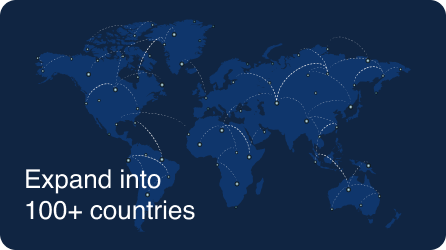Cooking up global expansion strategies to expand your business?
Formulating strategies before expanding globally is mandatory. And making considerations for international benefits and compensation while developing these strategies is essential too. But why?
You must comply with all necessary statutory requirements when developing a global compensation package. So, an efficient compensation and benefits plan is a must to:
- get positive feedback and increase trust
- attract and retain employees, and
- witness higher productivity.
In this article, you will learn about the process of structuring and planning international benefits and compensation plans.
What is International Compensation and Benefits?
International compensation and benefits are overseas compensation packages. The idea is to offer various perks and benefits for international employees to keep them engaged and productive.
International benefits and compensation packages include health insurance, travel allowance, bonuses, complimentary lunch/ breakfast, merit pay, etc.
International Compensation and Benefits Structure – Consideration
The main aim of international benefits and compensation packages is to keep employees motivated when they work overseas. So, the structure of the global benefits and compensation packages must be well-planned.
The international benefits and compensation package structure must be such that it covers all employees according to the local and foreign provisions available.
Aspiring for a structure can also assist in making informed decisions related to worker compensation for employees working overseas and global benefits strategy.
But, how to go about creating the international benefits and compensation structure?
Developing the international benefits and compensation structure involves a lot of research. Here’s a step-by-step guide to remember considering crucial factors.
Research your country of hiring
Study the country where you want to hire employees. You must thoroughly understand the employer’s obligations in the country into which you wish to expand.
With your due diligence, you’ll understand the difference between your local payment methods and the international ones.
So, what should you study about the country?
Since you are developing international benefits and a global compensation structure, you must have an overview of the foreign systems. So, study the available talent pool, skill sets, the country’s economy and its market, culture, laws, and policies to comply with, range of qualification, the readiness of workers, etc.
Suppose you are expanding to Japan. Your research on Japan must include the economy and market, collective bargaining, equal protection laws, compensation strategies, etc. Pursuing in-depth research will save you from wrong decisions, disbursing wrong global benefits, and even penalties.
Do-it-yourself or hire consultants.
Now it’s up to you to decide if you’ll prepare the international benefits and compensation structure by yourself or consult experts. You can undertake the process with your internal HR team or outsource the entire process to employment experts and/or agencies.
Preparing the international benefits and compensation structure all by yourself can be a challenging task, even if you take help from experts. However, you can consider counsel from external local experts to get insights into the country’s market and global benefits and compensation.
Taking such help might make the process manageable and way safer.
Multiplier’s Professional Employer Organization (PEO) solution can be a wise choice to onboard international employees, stay compliant with labor laws, and most importantly, manage international benefits and perks painlessly.
Competitors analysis
Whether it is about the international benefits or global compensation, make sure you offer better than your fellow competitors.
Consider studying the competitors in your home country and the targeted country in question. This will help you develop a competitive strategy that can enable you to edge out your competitors.
Consider your budget and salaries
One of the most important steps is to structure your budget and salary according to your analysis so far. You must include factors like:
- Number of employees you will need
- Prevailing workload
- Cost and standard of living in the foreign country
- Compensation system of the targeted country
- Rate of currency conversion, etc.
These aspects help you determine the extent of coverage for all employees, including remote and overtime workers. Thus, your global benefits strategy will be much more robust, and you will significantly reduce the possibility of errors.
Conduct employee classification
The next step in developing the international benefits and compensation structure is employee classification. You must classify the employees according to their responsibilities and contribution to the company, etc., to avoid errors in disbursing compensation.
For example, a freelancer and a full-time employee will have different responsibilities. Plus, their modes of contracts will also be different. Hence, classifying employees and matching the apt compensation will help you differentiate among all the positions in your company.
Defining the terms
Define your rewards and benefits structure well to avoid confusion, errors and to eliminate the risk of penalties.
For instance, define the terms’ employee’, ‘wage’, ‘bonus’, ‘allowance’, etc. Since these terms might have different meanings in different countries, defining them in your rewards plan is better.
Create a Compensation Plan
After you have built the international benefits and compensation structure, it’s time to develop the plan.
Creating an international compensation plan involves determining the way you will disburse the rewards. Plus, it will comprise your allocations plan, payment conditions, payment time, employee salaries, etc.
Here are a few steps that you can follow to create a good compensation plan.
- Identify vitals – employment objectives, business targets, number of employees, positions available, etc., and create a company outline.
- Train and equip the HR department to manage the international compensation plan. You can also outsource the process to any international PEO.
- Set the proper compensation for each position that you want to fill. Consider the factors influencing international compensation and the foreign customs and laws to ensure appropriate compensation for each post.
- Organize the job position hierarchically. Then allocate the rewards, global compensation, benefits like international insurance benefits, etc.
- Define the compensation plan and salary structure according to employee qualification, skills, contributions to the company, etc.
- Set a time in which the disbursement of rewards will take place for an employee. For example, employees are granted sabbatical leave only after five years of service in a few countries.
- Keep yourself updated with the statutory requirements. Ensure being compliant with the laws and regulations.
- Pay attention to the compensation structure and make adjustments when required.
- Ensure organizing reviews, communication activities, and meetings among employees at regular intervals. This will help you monitor the plan and its activeness. Also, you will be able to ensure employee satisfaction.
How To Ensure Your International Benefits and Compensation Plans are Competitive and Compliant?
When you are expanding to a new country, strive to outclass the minimum statutory requirements. Your international compensation and innovative benefit strategies must be enough to take over your competitors.
However, along with being competitive, make sure your plans are compliant too. To ensure maintaining a steady balance between compliance and competition, here are two options you can go for.
Try going beyond the minimum statutory requirement
You could also make the global compensation and international benefits package you offer your competitive advantage. Offering top-class benefits can turn into the reason why employees should work for you. So, whenever there’s an opportunity, try going beyond the minimum statutory requirements.
Research the international benefits and compensation that industry leaders are offering in the domestic market. Use the research to strategize your company’s offerings to stack up against the prevailing competition.
These international benefits will stand out in the crowd and may appear more attractive to the global workforce.
Ally with local HR experts
If you are going beyond the statutory requirements, you get an advantage when hiring local talents. But the benefit will not be of use if there are no compliant employment contracts in the local language.
To make hiring global talent easier, consider an alliance with local HR experts or international PEOs. These agencies will help you with laws, statutory requirements, international benefits, compensation, and employment contracts.
PEOs can assist you well and make the entire process less time-consuming. Plus, it can be cost-effective as well. The PEOs will ensure that your employment contracts comply with domestic laws. They will help you get an idea of the standard global compensation and customize a global benefits plan that can be competitive in the market.
Get The Multiplier Advantage
Handling international benefits and compensation can be exhausting. An intelligent way to manage these is by partnering with an international compensation consultant or a global PEO (Professional Employer Organization). It will be an actual win-win situation since you don’t have to worry about planning the compensation and benefits, and everything will be taken care of by the PEO.
And, if you’re looking for a PEO that can help you here, choose Multiplier.
Wondering why? Find out here:
- Multiplier enables you to offer homogenous international benefits and compensation policies for employees in 170+ countries.
- You can onboard international talent l with Multiplier in a matter of minutes.
- We help you save both time, cost, and effort
Want to explore further?
Schedule a free demo!
Frequently Asked Questions :
Q. What are the most common international benefits and compensation packages offered by companies?
While the benefits and compensation packages vary across countries, the following are the most common elements global companies offer:
• Gross Salary
• Cost-of-living Adjustment
• Health, Life, and Dental Insurance
• Housing Allowance
• Taxes and Tax Assistance
• Retirement Fund
• Paid leaves (vacations, sick leave, bereavement leaves, public holidays, and others)
Q. How can my company ensure equitable and fair compensation across a global workforce?
Follow the strategies below to ensure equitable and fair compensation in your workplace:
• Research and utilize salary surveys to understand the internal and market trends
• Prepare a compensation strategy and benchmark your pay against your competitors
• Conduct an internal pay audit to understand the needs and expectations of your workforce
• Practice pay transparency across all levels to uphold trust within the organization and defuse any wage disparity
• Give a compensation preview to your employees and interviewing candidates to identify issues and quickly resolve them
Q. What impact can an international benefits and compensation package have on employee retention and satisfaction?
A comprehensive international benefits and compensation package can positively impact a company’s retention strategies. With a desirable benefits and compensation package, companies will be able to:
• Attract and retain top talent, as the professional will feel more valued and motivated
• Increase job satisfaction of the talent leading to better engagement, commitment, and productivity
• Earn trust of the employees and make enhance their loyalty
• Build a positive corporate culture as the employees will be motivated to achieve their goals and take the company forward
Q. How to comply with local laws and regulations while designing an international benefits and compensation package?
Follow the given steps to ensure your international benefits and compensation package complies with all the relevant labor laws:
• Research the domestic and global labor laws that are applicable to your candidates
• Speak to legal experts or your PEO/EOR partner to ensure your benefits and compensation package are fully compliant and carry no legal risks
• Curate the package to the particular needs of the employees in each nation, this includes offering most common perks and industry-standard salary
• Communicate with the employee and explain them all the regulations to ensure full transparency
• Document the entire compliance process as part of your HR policy, to gather evidence supporting your compliance measures


